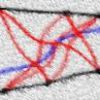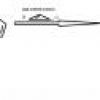 21
21So at least one or at most 2 of a,b,c must not be in the range of f.
when a is not in the range no. of function = 24(distribute among b and c) = 16
similarly for b and c. when any two (say a,b) are not in the range only one arrangements in each cases. (all goes to c).
By principle of inclusion and exclusion
|AU B U C| = |A| + |B| + |C| - |A∩B| - |B∩C| - |C∩A| + |A∩B∩C| = 2* 16 - 3 = 45
 1
1yeah 45.
onto functions implies at most 2 elements from set B must be considered.
case 1 : exactly 1 elment from set B is considered ; 3 such functions are possible.
case 2 : exactly 2 elements from set B are considered ;
2^4 such functions are possible when you consider the doublet (a,b) , but 2 out of these 2^4 functions are repeated. so we consider only 2^4 - 3 for this and similarly 2 other doublets (b,c) and (c,d) are possible. so (2^4 - 2 )3.
.:. final answer = 3 + (2^4 - 2 )3 = 45
 21
21You could do that because it's a low dimension problem...